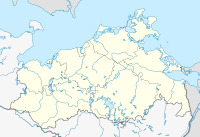Granitz nature reserve
Location of the NSG in Mecklenburg-Western Pomerania |

The Granitz nature reserve is a 1130 hectare nature reserve in Mecklenburg-Western Pomerania . It was placed under protection on September 12, 1990 as part of the establishment of the Southeast Rügen Biosphere Reserve . The coastal old forest sites with interspersed boiler moors together with the island of Vilm represent the major part of the core zone of the reserve and should develop without economic use in terms of process protection .
The towns of Binz , Sellin and Lancken-Granitz as well as the Baltic Sea are located nearby .
Overall, the state of the area is rated as good. However, the desired freedom of use of the areas has not yet been achieved. The rewetting of the boiler bogs has started. As part of the major nature conservation project Ostrügensche Boddenlandschaft , renaturation measures were carried out and the land was transferred to the property of the project sponsor, the Rügen Landscape Management Association.
According to EU law, the areas are part of the FFH area and bird sanctuary of the same name .
history
The Granitz was formed during the last ice age . Theories about its exact origin vary. It is assumed that the melting glacier would form meltwater, which was then postponed in a new phase of freezing. The areas have a strong relief with a high slope. Evidence for this is the largely deep-lying glacial till and overlying basin sands that are up to 70 meters thick. The moors in the eastern part of the area are all in basin layers.
Human settlement has been documented by the surrounding barrows since the Neolithic Age. However, the Granitz was always forested and, together with the Stubnitz, is one of the old forest areas on the island of Rügen. There is a well-preserved Slavic rampart near Schanzenort. The Swedish matriculation card and also field names indicate that the forests were used as forest pastures from the late Middle Ages. For centuries the Granitz was used as a hunting ground for the prince in Putbus, which is also reflected in the construction of the hunting lodge . In the 1970s, wood was removed extensively by means of clear felling. The areas were then afforested with spruce , larch and Douglas fir .
Flora and fauna
Depending on the soil conditions, the soils of the Granitz show a great variability in terms of the nutrient supply. The flora is adapted accordingly. The majority of the nature reserve is covered by beech forest with pearl grass , woodruff and golden nettle in the undergrowth. The slopes and hilltops are extremely poor in nutrients. Beech forests with fork tooth moss , white moss and other rare species of moss grow here. Only to the north are cliffs and beach areas on the Baltic coast . Typical species of the largely inactive cliffs are liverworts , finger sedge and orchids due to the base-rich subsoil .
Numerous boiler bogs can be found in the central part. In the still partially unentwässerten surfaces grow peat mosses , Tonquil , sedges , Eriophorum angustifolium and marsh cinquefoil . In the center of the moors you can also find Sumpf-Porst , Scheidiges Cottongrass and Cranberries .
The Black Lake in the east of the Granitz is bordered by silting bogs and a birch quarry in between.
Another moor can be found in the southwest of the nature reserve and Alder Quarry Forest stagnates east of Blieschow on the Kleinbahn .
Notable breeding birds in the area are teal duck , sparrowhawk , goshawk , white-tailed eagle , stock dove and red-backed killer . Slow worm, grass snake, wood lizard and sand lizard can be encountered. The snail fauna includes 35 species.
literature
- Granitz 188 . In: Ministry of Environment Mecklenburg-Western Pomerania (Hrsg.): The nature reserves in Mecklenburg-Western Pomerania . Demmler-Verlag, Schwerin 2003, ISBN 3-910150-52-7 , p. 140 f .
Web links
- NSG regulation (from § 4)
- Map portal environment of the State Office for the Environment, Nature Conservation and Geology Mecklenburg-Western Pomerania ( information ) with geodata
Individual evidence
- ↑ Forest development in the NSG Granitz with information on the transfer of land
- ↑ Standard data sheet FFH area Granitz (PDF; 54 kB)
- ↑ Standard data sheet for the EU bird sanctuary Granitz (PDF; 76 kB)
- ^ Burgwall (Granitz 8) information from the KLEKs
- ↑ Biotope arch of inactive cliff east of Binz (PDF; 24 kB) for more see map portal environment of the State Office for the Environment, Nature Conservation and Geology Mecklenburg-Western Pomerania ( information )
- ↑ habitat bow Postmoor south-west. "Large meadow" (PDF; 24 kB)
- ↑ Biotope arch Kesselmoor "Dolge" in the northern part of the Granitz (PDF; 20 kB)
- ↑ Biotope arch Kesselmoor "Große Wiese" on the northern edge of the Granitz (PDF; 20 kB)
- ↑ Kesselmoor biotope arch in the northern part of the Granitz (PDF; 20 kB)
- ↑ Biotope arch silting moor at the southern end of the Black Lake (PDF; 20 kB)
- ↑ Biotope arch on the Schwingmoor at the Black Lake (PDF; 20 kB)
- ↑ Biotope arch Birkenbruch am Schwarzen See (PDF; 20 kB)
- ↑ Biotope arch moor complex southeast of Neu Süllitz (PDF; 20 kB)
- ↑ Biotope arches Erlenbruchwald at the "Rasenden Roland" east of Blieschow (PDF; 18 kB)
Coordinates: 54 ° 23 '14.5 " N , 13 ° 38' 53.2" E



